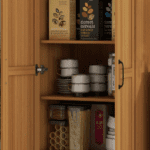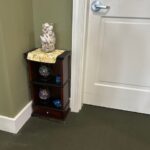It’s a New Dawn: Making The Transition to Senior Living Communities – Part One: Settling In
 Submitted by Lori K. Yauch
Submitted by Lori K. Yauch
M.A., CCC-SLP
Owner/Manager
Meaningful Memory Maker
“It’s a new dawn. It’s a new day. It’s a new life for me, and I’m feeling good.” (Anthony Newley, Leslie Bricusse, 1964)

Embracing The “New Dawn
As I transition to my new life, I’ve gained a deeper understanding of the challenges faced by individuals with dementia, as well as their families and care partners when moving to independent or assisted living communities. I want to share some insights on making this transition smoother while maintaining a sense of autonomy.
It’s crucial to remember that even in a new environment, your loved one’s (“Maggie”) independence and decision-making should be respected. This respect can significantly enhance her overall quality of life, fostering a sense of control and stability. Respecting Maggie’s autonomy is key to a successful transition.
What to Put in the Box to the Left
 As you declutter Maggie’s living space and decide ‘what to take and leave behind,’ remember the value of treasured possessions. When packing these items, it’s crucial to highlight those with special meaning. Each piece tells a story, from the unique Shipley Temple cup and delicate porcelain music box to Lladró figurines. These items, along with favorite books, music, DVDs, and family photos, not only create a comforting sense of continuity amid change but also serve as a reminder of Maggie’s identity, providing reassurance and comfort to all involved. Allowing Maggie to assist in choosing the ‘treasures’ she would like to take with her gives her a sense of purpose and control, fostering stability and comfort.
As you declutter Maggie’s living space and decide ‘what to take and leave behind,’ remember the value of treasured possessions. When packing these items, it’s crucial to highlight those with special meaning. Each piece tells a story, from the unique Shipley Temple cup and delicate porcelain music box to Lladró figurines. These items, along with favorite books, music, DVDs, and family photos, not only create a comforting sense of continuity amid change but also serve as a reminder of Maggie’s identity, providing reassurance and comfort to all involved. Allowing Maggie to assist in choosing the ‘treasures’ she would like to take with her gives her a sense of purpose and control, fostering stability and comfort.
Creature Comforts
Speaking of comfort, don’t forget to include those items that bring physical comfort. The bed Maggie sleeps in, the recliner she naps in, the love seat that holds memories of cozy nights by the fire. Her favorite Afghan crocheted with her mother, the familiar set of dishes, and a favorite coffee cup will help the new space feel more like home. These familiar items create a comforting environment for Maggie and her care partners. Including “creature comforts” reassures care partners that they are doing their best to make the transition to the new living space as smooth as possible.
Decorating the Physical Space
 All the spaces should be wide open and clutter-free. If large rugs or carpets are used, they should be secured in place with furniture or two-sided tape to prevent slips and falls that could cause injury. When considering the color of the floor covering, light to medium shades are better than dark or stark white colors. Both extremes reduce contrast. Dark colors are perceived as holes in the floor, and the combination of light and dark together increases confusion.
All the spaces should be wide open and clutter-free. If large rugs or carpets are used, they should be secured in place with furniture or two-sided tape to prevent slips and falls that could cause injury. When considering the color of the floor covering, light to medium shades are better than dark or stark white colors. Both extremes reduce contrast. Dark colors are perceived as holes in the floor, and the combination of light and dark together increases confusion.
When placing furniture (whether old or new), it’s essential to use a similar layout to that used in her previous home. (The bed, nightstand, and dresser are all in the same position. The bathroom sink, toiletries, and towels are arranged in the same position and the same drawers.) This familiarity can help Maggie feel more at home in the new environment, reducing the stress of the transition.
When decorating the bookshelves, end tables, countertops, and a baker’s rack with Maggie’s “treasures,” allow her to place or direct the placement of these items, paying attention to positioning them where they can be seen and enjoyed. Make sure all areas are well-lit and that night lights are generously placed to ensure nighttime safety.
All Dressed Up
 As you transition from large spaces to smaller ones (such as closets and drawers), organize them in the way Maggie prefers. (The dresser drawer on the left has socks and undergarments, the center has jewelry, the ends house t-shirts, and the subsequent drawers house sweaters. Consider labeling the drawers, as memory skills may change over time, while reading skills tend to remain intact for a longer period. Continue in the same fashion in the closet (Blouses on the left, slacks in the middle, jackets on the right, and shoes underneath the jackets). Presenting her clothes in this way can also enhance Maggie’s ability to continue dressing independently. (Following the retrieval of underclothes from the dresser, Maggie reaches for a blouse, slacks, jacket/sweater, and shoes). When choosing her clothes becomes more difficult, try assembling outfits with her (“Do you like the navy slacks with the gray sweater and white t-shirt?”) and hanging them in the closet in an ordered fashion with days of the week on the hangers. She now knows what the “outfit of the day” will be.
As you transition from large spaces to smaller ones (such as closets and drawers), organize them in the way Maggie prefers. (The dresser drawer on the left has socks and undergarments, the center has jewelry, the ends house t-shirts, and the subsequent drawers house sweaters. Consider labeling the drawers, as memory skills may change over time, while reading skills tend to remain intact for a longer period. Continue in the same fashion in the closet (Blouses on the left, slacks in the middle, jackets on the right, and shoes underneath the jackets). Presenting her clothes in this way can also enhance Maggie’s ability to continue dressing independently. (Following the retrieval of underclothes from the dresser, Maggie reaches for a blouse, slacks, jacket/sweater, and shoes). When choosing her clothes becomes more difficult, try assembling outfits with her (“Do you like the navy slacks with the gray sweater and white t-shirt?”) and hanging them in the closet in an ordered fashion with days of the week on the hangers. She now knows what the “outfit of the day” will be.
As the dementia journey continues and Maggie requires assistance to dress (or complete any activity of daily living), remember to include her in the choice. Providing her with a choice is a courtesy and a way to preserve her sense of control and autonomy in her environment. This approach, which respects Maggie’s choices, makes her feel more comfortable and in control and makes care partners feel more respectful and considerate.
Time For A Snack
 A sense of control is essential when considering the business of eating. As Maggie progresses through the stages of dementia, the one thing she has complete control over is what goes in her mouth. Therefore, within nutritional and swallowing safety guidelines, stock her kitchen with her favorite snacks (puddings, cottage cheese, yogurt, ice cream, muffins, cookies, crackers, juices, bottled water, and soft drinks). They should be placed on lower shelves in the cabinets and refrigerator, so they are easily visible. Provide disposable plastic utensils, paper plates, and cups for daily use in separate, labeled drawers to minimize the risk of injury from sharp knives or forks and reduce the likelihood of insects invading the living space if dishes are left unwashed in the sink. This approach ensures that Maggie’s nutritional needs are met, allowing her to make choices and maintain control over her daily routine, which is crucial for her overall well-being.
A sense of control is essential when considering the business of eating. As Maggie progresses through the stages of dementia, the one thing she has complete control over is what goes in her mouth. Therefore, within nutritional and swallowing safety guidelines, stock her kitchen with her favorite snacks (puddings, cottage cheese, yogurt, ice cream, muffins, cookies, crackers, juices, bottled water, and soft drinks). They should be placed on lower shelves in the cabinets and refrigerator, so they are easily visible. Provide disposable plastic utensils, paper plates, and cups for daily use in separate, labeled drawers to minimize the risk of injury from sharp knives or forks and reduce the likelihood of insects invading the living space if dishes are left unwashed in the sink. This approach ensures that Maggie’s nutritional needs are met, allowing her to make choices and maintain control over her daily routine, which is crucial for her overall well-being.
After setting up Maggie’s pantry with her favorite snacks, consider ways to help her enjoy her meals with her peers in the Common Dining Area. Ensure that the staff is aware of her preferences and offers her a choice between two entrees and two beverages (“Meat or Fish?” and “Coffee or Tea?”). Avoid providing a menu, as the text may be difficult to read unless pictures accompany it. Additionally, offering more than two or three written choices may overwhelm her.
It’s A New Day
As Maggie settles into new surroundings, ensure she knows the “routine.”
- Post mealtimes and shower days in bold letters on dementia-friendly bright green paper in areas where she will see it. (The back of the apartment door, the bathroom door)
- List important phone numbers and place them near the phone or recliner.
- Set the alarm on her iPhone for the “wake-up time” she prefers.
- If she requires assistance with medication, ensure she is aware of the nurse or medical technicians who provide this service so she will accept their daily visits.
Welcome Home
 The final touch to “Settling In” should be decorating the entry from the hallway to the door. Placing a beloved door decoration or a knick-knack cabinet containing meaningful treasures will be an excellent landmark for Maggie to look for when returning to her apartment after a day out and about, meeting new friends, and having exciting adventures.
The final touch to “Settling In” should be decorating the entry from the hallway to the door. Placing a beloved door decoration or a knick-knack cabinet containing meaningful treasures will be an excellent landmark for Maggie to look for when returning to her apartment after a day out and about, meeting new friends, and having exciting adventures.
Now settled in this new living environment, Maggie and her care partners feel excitement and joy and have found solace in knowing she is in a safe and nurturing space. This fresh chapter is filled with opportunities for growth, connection, and happiness, allowing everyone to embrace the brighter days ahead.
 Submitted by Lori K. Yauch
Submitted by Lori K. Yauch
M.A., CCC-SLP
Owner/Manager
Meaningful Memory Maker


